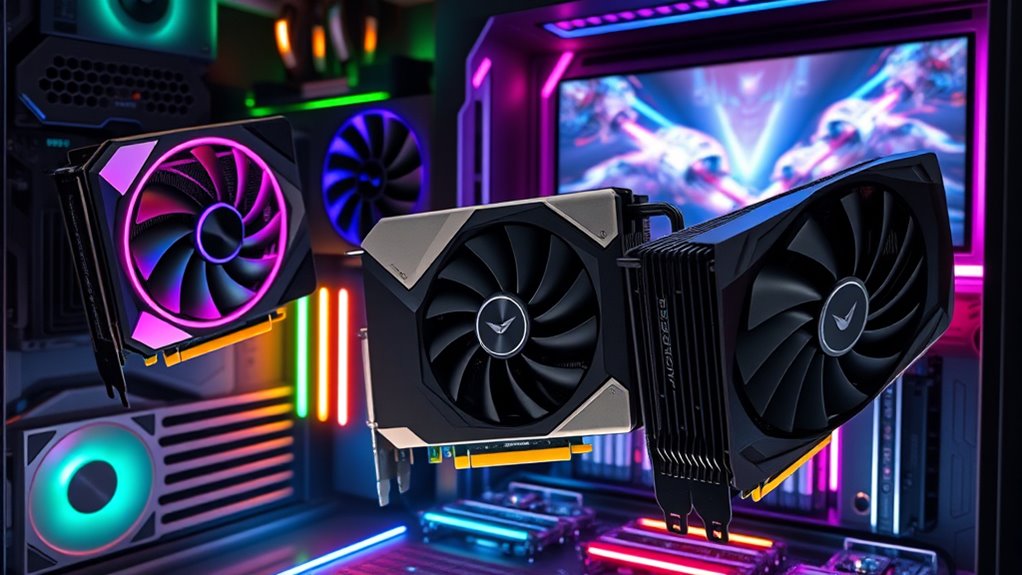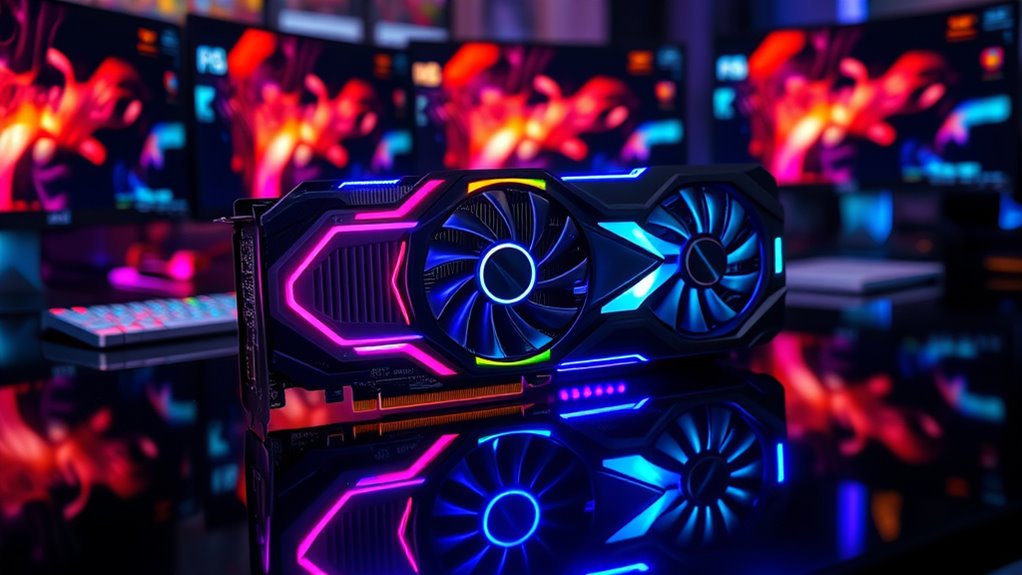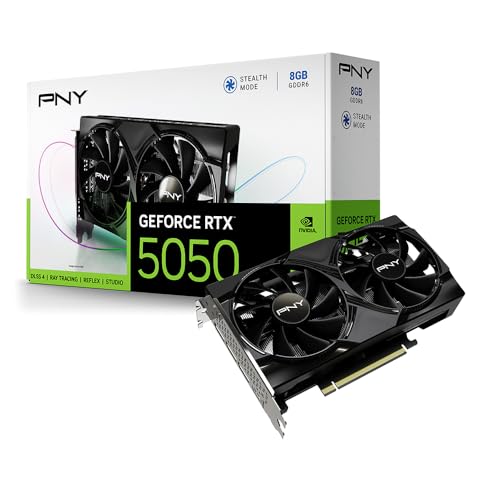If you’re looking for the top premium graphics cards in 2025, I recommend models like the ASUS TUF Gaming GeForce RTX 5070 Ti, GIGABYTE RTX 5050, and AMD Radeon RX series for unbeatable power, performance, and future-proof features. These cards offer high VRAM, advanced cooling, and support for 4K and beyond. They may come at a premium, but they deliver outstanding results for gaming and creative work. Continue to explore how these options can elevate your setup.
Key Takeaways
- Top-tier options like NVIDIA GeForce RTX 4070 Ti and AMD Radeon RX 9060 XT deliver exceptional gaming performance for 2025.
- Advanced features such as DLSS 4, PCIe 5.0, and high VRAM boost future-proofing and immersive gameplay.
- Cooling systems, design, and build quality ensure reliable performance under demanding workloads and extended gaming sessions.
- Compatibility with modern high-resolution displays (up to 7680×4320) and multi-monitor setups enhances visual experience.
- Pricing varies with premium models, offering a balance between cutting-edge technology, power, and investment for high-end gaming rigs.
GIGABYTE GeForce RTX 3060 Gaming OC 12G Graphics Card
The GIGABYTE GeForce RTX 3060 Gaming OC 12G is an excellent choice for gamers and creative professionals who want high performance without breaking the bank. Powered by NVIDIA’s Ampere architecture, it offers real-time ray tracing with 2nd Gen RT Cores and AI acceleration via 3rd Gen Tensor Cores. With 12GB of GDDR6 memory, a 192-bit interface, and a core clock of 1837 MHz, it handles demanding games and creative workloads smoothly. The WINDFORCE 3X cooling system keeps temperatures in check, while RGB Fusion 2.0 adds customizable lighting. It strikes a solid balance of power, features, and affordability for a wide range of users.
Best For: budget-conscious gamers and creative professionals seeking high VRAM capacity and reliable performance for gaming, AI, and creative workloads.
Pros:
- Excellent performance with high FPS in gaming and creative tasks
- 12GB GDDR6 memory ideal for large models and high-resolution content
- Effective cooling system with quiet operation and RGB customization
Cons:
- Can run hot under intensive gaming, reaching temperatures around 75°C
- Slightly overpriced compared to some competitors
- Limited support for DirectX 12 APIs, which may affect some newer titles
MSI GeForce RTX 3060 12GB Graphics Card
If you’re building a gaming rig that balances performance and affordability, the MSI GeForce RTX 3060 12GB is an excellent choice, especially for gamers targeting 1080p and 1440p resolutions. It features NVIDIA’s Ampere architecture, with a boost clock of 1710 MHz and 12GB of GDDR6 VRAM, ensuring smooth gameplay and future-proofing. The dual Torx Twin Fan cooling keeps temperatures low and noise minimal, while its three DisplayPort and one HDMI port support up to 8K resolution. Easy to install and compatible with PCIe 4.0, it offers reliable performance for gaming and creative tasks at a compelling price point.
Best For: gamers and creative professionals seeking a high-performance, affordable graphics card optimized for 1080p and 1440p gaming, as well as demanding creative tasks.
Pros:
- Excellent performance for 1080p and 1440p gaming with smooth frame rates
- 12GB of GDDR6 VRAM provides future-proofing for demanding applications
- Quiet and efficient dual Torx Twin Fan cooling system ensures low temperatures and minimal noise
Cons:
- Requires a power supply of around 550-600W with at least an 8-pin power connector
- Larger size may not fit in very compact cases
- Limited to PCIe 4.0 compatibility, which may be less optimal on older motherboards
ASUS TUF Gaming GeForce RTX 5070 Ti 16GB Graphics Card
For gamers and creators seeking top-tier performance in 2025, the ASUS TUF Gaming GeForce RTX 5070 Ti 16GB stands out thanks to its advanced NVIDIA Blackwell architecture and DLSS 4 technology, delivering stunning graphics and smooth gameplay at high resolutions. Built with military-grade components, it offers exceptional durability, efficient cooling with axial-tech fans, and a robust design that supports overclocking. Its 16GB GDDR7 memory handles demanding tasks effortlessly, while temperatures stay low even under heavy loads. With a sleek black aesthetic, easy installation, and compatibility with ASUS systems, this card provides excellent value for those wanting premium performance without breaking the bank.
Best For: gamers and content creators seeking high-performance, durable graphics with advanced features in 2025.
Pros:
- Exceptional performance with NVIDIA Blackwell architecture and DLSS 4 technology for smooth, high-quality graphics.
- Robust build quality with military-grade components, effective cooling, and overclocking support.
- Ample 16GB GDDR7 memory and low operating temperatures ensure reliability for demanding tasks.
Cons:
- Large size requires spacious PC cases, which may limit compatibility.
- Premium features come at a higher price point compared to some competitors.
- Support bracket may be ineffective for some users, needing additional customization or reinforcement.
ASUS TUF Gaming GeForce RTX 5070 Ti 16GB Graphics Card
With its NVIDIA Blackwell architecture and 16GB GDDR7 memory, the ASUS TUF Gaming GeForce RTX 5070 Ti 16GB clearly stands out for gamers and creators seeking premium performance at 4K resolutions. It features robust cooling with axial-tech fans and phase-change thermal pads, ensuring low temperatures and quiet operation even under heavy loads. The card supports PCIe 5.0, HDMI 2.1, and DisplayPort 2.1, making it highly compatible with modern setups. Its durable construction includes military-grade components and a protective PCB coating. With a boost clock of 2610 MHz and 1484 AI TOPS performance, it delivers smooth gameplay and efficient rendering for demanding tasks.
Best For: gamers and content creators seeking high-performance 4K gaming, professional rendering, and future-proof VRAM capacity.
Pros:
- Excellent 4K gaming performance with high frame rates and ray tracing capabilities
- Robust cooling system with axial-tech fans and phase-change thermal pads for low temperatures and quiet operation
- Durable construction with military-grade components and extensive compatibility with modern interfaces
Cons:
- Large size may pose installation challenges in small or compact cases
- Priced approximately $200 above MSRP, which could be a concern for budget-conscious buyers
- Limited overclocking headroom compared to some larger, more premium models
Radeon RX 580 8GB Graphics Card for PC Gaming
The Radeon RX 580 8GB Graphics Card stands out as an excellent choice for budget-conscious gamers who want reliable performance without sacrificing visual quality. Built on a 14nm process, it features 2048 Stream Processors and 8GB GDDR5 memory, supporting 4K resolution and multi-monitor setups. It delivers smooth gameplay in titles like Star Wars: Jedi Survivor and Baldur’s Gate 3 at medium to ultra settings, with 30-60 fps. Its dual cooling fans and composite heat pipes keep it cool and quiet. Easy to install and compatible with most systems, it offers great value, especially for those upgrading older PCs or seeking solid performance at an affordable price.
Best For: budget-conscious gamers and users seeking reliable, high-quality graphics performance on older or mid-range systems.
Pros:
- Supports 4K resolution and multi-monitor setups for immersive experiences
- Quiet operation with dual cooling fans and composite heat pipes
- Easy to install and compatible with most systems, offering great value for its price
Cons:
- Fan may require replacement over extended use
- Slightly lower SP count compared to full RX 580 models, potentially affecting performance in demanding tasks
- Limited overclocking headroom due to cooling and power constraints
GIGABYTE GeForce RTX 5070 Ti Gaming OC 16G Graphics Card
Equipped with NVIDIA’s Blackwell architecture and DLSS 4, the GIGABYTE GeForce RTX 5070 Ti Gaming OC 16G is an excellent choice for gamers seeking top-tier performance at a competitive price. It features 16GB GDDR7 memory, PCIe 5.0 support, and a max resolution of 7680×4320 pixels, making it perfect for 1440p and 4K gaming. The WINDFORCE cooling system keeps temperatures low and noise minimal, even during demanding sessions. Users praise its stability, quiet operation, and ability to handle ray tracing smoothly. With performance surpassing previous models like the RTX 3070 Ti, it offers excellent value for high-end gaming and creative workflows.
Best For: gamers and creative professionals seeking high-performance graphics with excellent ray tracing capabilities at a competitive price point.
Pros:
- Delivers exceptional 1440p and 4K gaming performance with high frame rates and stunning visuals
- Supports advanced features like DLSS 4, PCIe 5.0, and enhanced ray tracing for realistic graphics
- Maintains cool and quiet operation thanks to the WINDFORCE cooling system, ideal for long gaming or creative sessions
Cons:
- Slightly larger size may require careful case compatibility
- Limited availability or potential packaging issues reported by some users
- May require additional power supply considerations depending on system configuration
Sapphire Pulse AMD Radeon RX 9060 XT Graphics Card with 16GB GDDR6
If you’re looking for a compact and efficient graphics card that delivers high performance without breaking the bank, the Sapphire Pulse AMD Radeon RX 9060 XT with 16GB GDDR6 is an excellent choice. It features 16GB of GDDR6 memory, supports AMD RDNA 4 architecture, and has a sleek, lightweight design measuring just 9.45 x 4.88 inches. Perfect for small builds, it offers strong gaming capabilities at 1440p and even 4K, handling demanding titles with ease. Its quiet operation, efficient cooling, and solid power efficiency make it ideal for budget-conscious gamers wanting future-proof VRAM and compatibility with modern systems.
Best For: budget-conscious gamers and small-form-factor PC builders seeking high performance, future-proof VRAM, and quiet operation.
Pros:
- Compact, lightweight design ideal for small builds and external GPU setups
- 16GB GDDR6 VRAM ensures future-proofing for demanding applications and upcoming gaming engines
- Quiet operation with effective cooling and high efficiency during gaming and professional tasks
Cons:
- Limited aesthetic features, lacking LED lighting or flashy design elements
- Power consumption peaks around 170W, which may require adequate PSU considerations
- Slightly higher price point compared to older or less feature-rich models in the same category
RX 5700 XT 8GB Graphics Card with Dual Cooling Fans
For gamers seeking a reliable balance of performance and cooling, the RX 5700 XT 8GB Graphics Card with dual cooling fans stands out as an excellent choice. It features GDDR6 memory, a 256-bit interface, and supports DirectX 12, delivering fast data transfer and high bandwidth for smooth 1440p gaming. Built on 7nm technology, it handles demanding textures and complex scenes efficiently. The dual fans with ball bearings and intelligent control keep temperatures low while maintaining quiet operation, even during intense gaming sessions. With multiple display outputs and PCIe 4.0 support, this card offers excellent value, performance, and reliability for both gamers and content creators.
Best For: gamers and content creators seeking a high-performance graphics card with reliable cooling and high-quality visuals at 1440p resolution.
Pros:
- Excellent gaming performance with high FPS and smooth visuals at 1440p
- Efficient dual cooling system with low noise and quiet operation
- Supports advanced features like PCIe 4.0, DirectX 12, and multiple display outputs
Cons:
- Requires two 8-pin PCIe power connectors, which may add cable clutter
- Slightly large dimensions that may not fit in smaller cases
- Limited to 8GB GDDR6 memory, potentially less future-proof for very demanding workloads
GIGABYTE 2GB RAM DDR3 SDRAM Video Graphics Cards GV-N710D3-2GL REV2.0
The GIGABYTE GV-N710D3-2GL REV2.0 stands out as an ideal choice for users seeking an affordable, low-profile graphics card primarily suited for basic multimedia and everyday computing tasks. Featuring 2GB DDR3 SDRAM, it supports resolutions up to 4096×2160 and includes multiple ports like DVI-D, D-Sub, and HDMI. It’s compatible with Windows 7, 10, and 11 and fits into smaller cases thanks to its low-profile design. While not geared for gaming or graphics-intensive work, it’s praised for easy installation, quiet operation, and reliable performance for media playback, web browsing, and office tasks. However, its GDDR3 memory limits performance for demanding web multitasking.
Best For: users seeking an affordable, compact graphics card for basic multimedia, office tasks, and light media consumption without gaming or high-end graphics demands.
Pros:
- Easy to install and compatible with Windows 7, 10, and 11
- Compact low-profile design suitable for small cases
- Quiet operation with reliable performance for everyday tasks
Cons:
- Limited performance due to slow GDDR3 memory, not suitable for gaming
- Some compatibility issues with PCIe 2.0 x16 slots functioning as x8
- No included driver CD, requiring drivers to be downloaded from NVIDIA website
QTHREE GeForce GT 730 4GB DDR3 Graphics Card
The QTHREE GeForce GT 730 4GB DDR3 Graphics Card stands out as an excellent option for budget-conscious users needing basic multimedia and light gaming performance. Its low-profile design makes it easy to install in compact and full-sized cases, supporting up to four monitors with HDMI, VGA, and DisplayPort outputs. With 4GB DDR3 memory clocked at 1000 MHz, it handles office tasks, HD video playback, and older games like Napoleon and Empire effectively. It’s compatible with Windows 11 and requires no external power, making it ideal for upgrading older PCs without breaking the bank. Overall, it’s a reliable choice for basic visual needs.
Best For: budget-conscious users seeking a reliable, basic graphics card for office work, multimedia, and light gaming in compact or full-sized cases.
Pros:
- Affordable price point with positive customer reviews
- Supports up to four monitors with multiple output options (HDMI, VGA, DisplayPort)
- Easy to install with low power requirements and plug-and-play setup
Cons:
- Limited gaming performance, struggles with newer titles
- Older technology may cause compatibility issues with some monitors or programs requiring higher specs
- Variability in durability and performance over time, with some users experiencing glitches
PowerColor Hellhound Spectral White AMD Radeon RX 9060 XT 16GB GDDR6 Graphics Card
If you’re building a mid-size gaming rig that demands high performance without sacrificing aesthetics, the PowerColor Hellhound Spectral White AMD Radeon RX 9060 XT stands out as an excellent choice. It features the AMD Radeon RX 9060 XT coprocessor with 16GB GDDR6 memory running at 20 GHz, supporting resolutions up to 7680×4320. Its compact size fits most mid-sized cases, and it offers smooth gameplay at 1440p and 4K, handling modern titles like Cyberpunk 2077 and Halo Infinite with ease. With dual DisplayPort 2.1a, HDMI 2.1b, and efficient cooling, this card combines power, style, and reliability for premium gaming experiences.
Best For: gamers seeking high-performance 4K and 1440p gaming in a mid-size case with a sleek, all-white aesthetic.
Pros:
- Excellent performance at 1080p, 1440p, and 4K with high frame rates across modern titles
- Compact design suitable for mid-sized cases with effective cooling and quiet operation
- Durable build with factory overclocking, dual 8-pin power connectors, and appealing aesthetics
Cons:
- High market price which may be above entry-level budget options
- Variability in pricing and availability could affect affordability and accessibility
- Slightly heavy for smaller cases, weighing around 2.6 lbs, which may require careful case support
PNY NVIDIA GeForce RTX™ 5050 Graphics Card (8GB GDDR6, PCIe® 5.0)
For gamers and creative professionals seeking top-tier performance, the PNY NVIDIA GeForce RTX™ 5050 stands out with its advanced NVIDIA Blackwell architecture and 8GB GDDR6 memory. This card delivers impressive real-time ray tracing and AI features thanks to 4th-gen Ray Tracing Cores and 5th-gen Tensor Cores. Supporting PCIe® 5.0 and high resolutions up to 7680×4320, it’s built for demanding workflows and gaming. The dual-fan cooling system and sleek design make it SFF-ready, while DLSS 4 and Reflex technologies boost frame rates and responsiveness. Overall, it’s a reliable, high-performance choice for those seeking cutting-edge graphics in 2025.
Best For: high-performance gamers, creative professionals, and content creators seeking advanced graphics and AI-driven features for demanding workflows.
Pros:
- Supports high resolutions up to 7680×4320 for stunning visuals and multi-monitor setups
- Equipped with cutting-edge NVIDIA Blackwell architecture, 4th-gen Ray Tracing, and 5th-gen Tensor Cores for superior real-time ray tracing and AI capabilities
- SFF-ready design with dual-fan cooling and PCIe® 5.0 support, ideal for compact builds and future-proofing
Cons:
- Relatively heavy at 1.69 pounds, may require sturdy mounting in smaller cases
- Premium features may come at a higher price point compared to entry-level graphics cards
- Limited availability at launch, potentially affecting immediate purchase options
ASUS TUF Gaming GeForce RTX 5080 16GB Graphics Card
Powered by NVIDIA’s Blackwell architecture and supporting DLSS 4, the ASUS TUF Gaming GeForce RTX 5080 16GB stands out as an ideal choice for serious gamers and creative professionals seeking top-tier performance. It features a robust 3.6-slot design with axial-tech fans, vapor chamber cooling, and phase-change GPU thermal pads, ensuring peak thermal management and durability. With a maximum resolution of 7680×4320 pixels, high clock speeds, and overclocking potential, it handles demanding AAA titles and creative workloads with ease. Built with military-grade components and a premium aesthetic, it delivers reliable, quiet operation and exceptional performance for gaming, VR, and professional tasks.
Best For: gamers and creative professionals seeking top-tier performance for 4K gaming, VR, video editing, and AI workloads.
Pros:
- Exceptional 4K gaming performance with high FPS and ray tracing capabilities
- Robust cooling system with vapor chamber and phase-change thermal pads for optimal thermal management
- Durable build with military-grade components and premium aesthetic design
Cons:
- Large and heavy, requiring ample space inside the PC tower
- More expensive due to its premium features and high performance
- Some users noted minor manufacturing issues like bent fins and increased plastic usage
GIGABYTE GeForce RTX 5050 Gaming OC 8G Graphics Card
The GIGABYTE GeForce RTX 5050 Gaming OC 8G stands out as an excellent choice for gamers seeking high performance and advanced features in a compact design. Powered by NVIDIA’s Blackwell architecture, it offers DLSS 4, enhanced RT and Tensor Cores, and ray tracing support for stunning visuals. With 8GB of GDDR6 memory and PCIe 5.0, it delivers fast frame rates from 1080p to 4K gaming, even running demanding titles like Cyberpunk 2077 at medium settings. Its WINDFORCE cooling system and compact size guarantee stable performance with temperatures in the mid-60s, making it perfect for high-resolution gaming in a small form factor.
Best For: gamers and creative professionals seeking high-performance graphics with advanced features in a compact, efficient design.
Pros:
- Supports ray tracing, DLSS 4, and Frame Generation for enhanced visuals and smooth gameplay.
- Compact size and advanced cooling system ensure stable performance in small form factor setups.
- Overclocking potential increases performance by approximately 20%, ideal for 4K gaming.
Cons:
- Limited to 8GB GDDR6 memory, which may be insufficient for very demanding future titles.
- Compatibility requires PCIe Gen 4 systems; may not fully leverage PCIe 5.0 bandwidth on older motherboards.
- Slightly higher price point compared to entry-level cards, reflecting its advanced features.
RX 580 8GB Graphics Card for Gaming PCs
If you’re building a budget-friendly gaming rig that still delivers solid performance, the RX 580 8GB Graphics Card stands out as an excellent choice. It’s built on 14nm architecture with 2048 stream processors and 8GB GDDR5 memory, handling AAA titles smoothly with high frame rates and vibrant visuals. It supports up to two displays via HDMI and DisplayPort, ideal for multitasking or multi-monitor setups. The cooling system with dual fans keeps temperatures in check, and the semi-automatic fan control reduces noise during idle. Overall, it offers good value for gamers on a budget, though some users report display port issues and compatibility concerns.
Best For: budget-conscious gamers and PC enthusiasts seeking reliable performance for AAA titles and multi-monitor setups.
Pros:
- Excellent performance for its price, handling modern AAA games smoothly with high frame rates.
- Supports multi-monitor configurations with 1 HDMI and 3 DisplayPort outputs.
- Effective cooling system with semi-automatic fans reduces noise and maintains optimal temperatures.
Cons:
- Some users experience display port functionality issues, affecting multi-monitor use.
- Larger footprint may not fit in smaller or compact PC cases.
- Occasional reports of PC crashes after prolonged use, raising concerns about longevity.
Factors to Consider When Choosing Premium Graphics Cards for Gaming Rigs

When choosing a premium graphics card, I focus on performance benchmarks to guarantee it can handle the latest games smoothly. I also check compatibility requirements, cooling solutions, and power supply needs to avoid any setup issues. Finally, VRAM capacity is critical for future-proofing and high-resolution gaming.
Performance Benchmarks
Ever wonder how to judge a premium graphics card’s true performance? Benchmarks are your best guide. I look at FPS in popular games, focusing on models that hit 144 FPS or more at 1440p or 4K, ensuring smooth gameplay. Synthetic benchmarks like 3DMark or PassMark give standardized scores for cross-model comparisons, revealing raw power. Real-world testing goes beyond numbers, evaluating thermal performance, noise levels, and stability during long gaming sessions. Features like ray tracing, DLSS, or FSR also impact performance, especially at higher settings. By reviewing benchmark results across multiple titles and workloads, I get a clearer picture of how a GPU performs in diverse scenarios. This in-depth approach helps me pick the best card for both gaming and creative tasks, balancing power and efficiency.
Compatibility Requirements
Choosing the right premium graphics card requires careful attention to compatibility factors that guarantee smooth integration with your existing system. First, check that your motherboard supports the PCIe slot version (PCIe 4.0 or 5.0) to guarantee optimal performance. Next, verify that your power supply can handle the GPU’s wattage demands and has the necessary connectors, whether 6-pin, 8-pin, or 8+6-pin. Also, measure your PC case to confirm it can accommodate the card’s size, especially larger, multi-slot models. Don’t forget to assess your CPU and other components to prevent bottlenecks at high resolutions like 1440p or 4K. Lastly, guarantee your operating system and drivers support features like ray tracing, DLSS, or FSR to maximize your GPU’s capabilities.
Cooling Solutions
Selecting the right cooling solution is essential for maximizing your premium graphics card’s performance and lifespan. Modern high-end GPUs often feature multiple axial-tech fans, vapor chambers, or phase-change thermal pads to keep temperatures in check. These advanced cooling designs help maintain GPU temperatures below 60°C even during intense gaming sessions, ensuring stability and longevity. High-quality thermal management components like military-grade PCB coatings and efficient heat conductance materials further improve heat dissipation and durability. Proper airflow within the case, combined with well-designed cooling systems, prevents thermal throttling and keeps performance high over extended periods. Some premium GPUs also incorporate open vented heatsinks or custom cooling vents, boosting heat exhaust and reducing internal case temperature buildup, which contributes to overall system stability and longevity.
Power Supply Needs
When building a gaming rig with a premium graphics card, ensuring your power supply can handle the load is crucial. High-end GPUs typically need at least 600W to 750W, depending on the model and its power draw. Many premium cards require one or two 8-pin or 6+2-pin PCIe power connectors, so your power supply must have compatible connectors and adequate cabling. Power consumption can spike over 300W during intense gaming or rendering, so a reliable, high-quality power supply is essential for stability. Using a wattage that’s too low or an outdated unit can cause crashes, system instability, or even hardware damage. I recommend choosing an 80 PLUS Gold (or better) rated power supply for efficient, stable power delivery with less heat and noise.
VRAM Capacity
VRAM capacity plays a crucial role in determining how well a premium graphics card performs, especially at higher resolutions and demanding workloads. When you game at 4K or work with complex 3D models, more VRAM—such as 12GB or 16GB—enables smoother performance and better detail handling. It also guarantees your system can run modern games with ultra settings without sacrificing frame rates. For future-proofing, choosing a card with ample VRAM helps keep up with evolving textures, shaders, and AI features. Additionally, large VRAM is indispensable for managing big textures, multiple monitors, and intensive tasks like video editing, reducing stuttering. Balance VRAM with core GPU power to maximize both gaming and creative workflows effectively.
Size and Fit
Choosing the right graphics card isn’t just about performance; size and fit are equally vital to guarantee compatibility with your gaming rig. Before buying, measure your case’s interior dimensions to ensure the card’s length, width, and height will fit comfortably. Larger cards like the ASUS RTX 5080, which can exceed 16 inches, need spacious cases with ample clearance. Also, check if your case supports multi-slot designs, especially for cards occupying 2.5 or 3.0 slots, to avoid fit issues. Keep in mind the card’s weight and mounting needs—heavier models with metal backplates might require extra support to prevent sagging. Finally, review the PCIe slot placement and surrounding space to guarantee proper airflow and cooling, essential for maintaining performance and longevity.
Price and Value
Premium graphics cards come with a hefty price tag, but their higher performance, advanced features, and longer lifespan often justify the investment. When evaluating value, I focus on balancing performance capabilities with cost, making sure the card meets my gaming and workload needs. Price fluctuations and market demand can considerably impact costs, so timing your purchase or price matching is wise for getting the best deal. Higher VRAM versions, like 16GB or more, are worth considering for high-resolution gaming and creative tasks, even if they cost more. Comparing the cost-to-performance ratio across models helps me identify the most cost-effective option, ensuring I don’t overspend on features I won’t utilize. Ultimately, the right balance of price and value ensures a smart, future-proof investment.
Future-Proof Features
When selecting a high-end graphics card, it’s essential to consider features that will keep your system relevant for years to come. Look for large VRAM capacities—16GB or more—to handle future high-resolution games and creative tasks. Support for the latest interface standards like PCIe 5.0 ensures faster data transfer and better compatibility with upcoming systems. Advanced ray tracing and AI acceleration technologies, such as DLSS 4 or Frame Generation, provide stunning visuals and smoother gameplay as game engines evolve. Compatibility with future display standards like HDMI 2.1 and DisplayPort 2.1 allows for higher resolutions and refresh rates on upcoming monitors. Additionally, enhanced overclocking potential and improved thermal management help maintain performance longevity and adaptability to future hardware and software demands.
Frequently Asked Questions
How Do Graphics Card Power Consumption Impact Gaming Rig Setup?
Graphics card power consumption directly impacts my gaming rig setup because higher power needs mean I need a more robust power supply to guarantee stability and prevent crashes. It also affects cooling requirements, as more power often produces more heat. I have to balance performance with efficiency, choosing a card that offers great gaming performance without overloading my system or raising my electricity bill too much.
What Future-Proofing Features Should I Prioritize in 2025?
When future-proofing my gaming rig in 2025, I prioritize features like ray tracing capabilities, DLSS or similar AI upscaling tech, and support for high refresh rates and resolutions. I also look for compatibility with upcoming PCIe standards and plenty of VRAM. These features guarantee I stay ahead of the curve, enjoy immersive visuals, and maximize my investment as games and technology evolve rapidly.
How Does Ray Tracing Performance Vary Among Premium Cards?
Imagine a world where visuals truly come alive—that’s what ray tracing promises. Among premium cards, performance varies based on architecture and core count. Some cards handle ray tracing effortlessly, delivering near-perfect reflections and shadows, while others require a bit more patience. I’ve found that top-tier models like the latest RTX series excel, but even mid-range options are making impressive strides. It’s all about balancing power and visual fidelity to suit your gaming dreams.
Are There Significant Differences in Warranty and Support Services?
Yes, I’ve noticed significant differences in warranty and support services among premium graphics cards. Some brands offer extended warranties and responsive customer support, which gives me peace of mind, especially when investing in high-end hardware. Others might have shorter coverage periods or less accessible support. I always recommend checking the warranty details and support options before making a purchase, so you’re prepared if issues arise.
What Is the Optimal Balance Between Price and Performance for High-End GPUS?
The perfect balance between price and performance for high-end GPUs in 2025 is around the $800–$1,200 range. I’ve found that this sweet spot offers incredible power without breaking the bank—think smooth 4K gaming with ray tracing and DLSS. Going beyond this range can give diminishing returns, while lower-priced options might struggle with the latest titles. For most enthusiasts, this range hits the sweet spot!
Conclusion
Ultimately, selecting the perfect premium graphics card depends on your gaming aspirations and budget. While top-tier options offer remarkable performance, even slightly more modest choices can elevate your experience without overwhelming your setup. By carefully weighing features and price, you’ll find a card that seamlessly complements your rig’s potential. After all, the right graphics card isn’t just about power, but about enhancing your gaming journey with elegance and finesse.

























